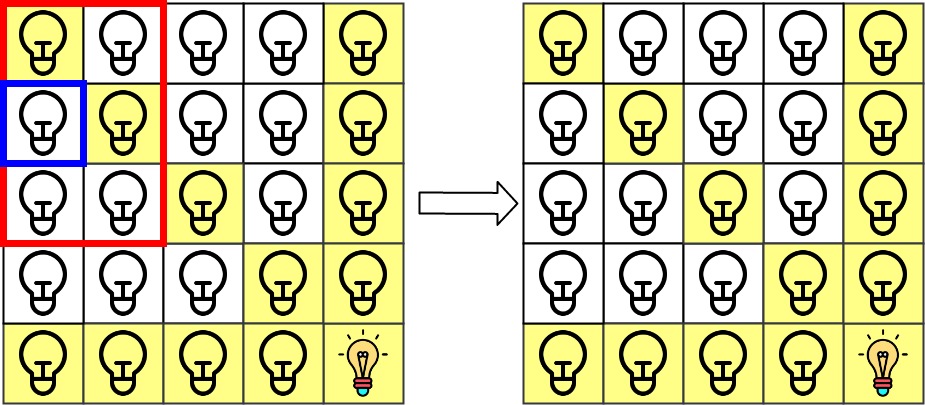
g1001_1100.s1001_grid_illumination.Solution Maven / Gradle / Ivy
package g1001_1100.s1001_grid_illumination;
// #Hard #Array #Hash_Table #2022_02_20_Time_75_ms_(90.57%)_Space_59_MB_(81.13%)
import java.util.HashMap;
/**
* 1001 - Grid Illumination\.
*
* Hard
*
* There is a 2D `grid` of size `n x n` where each cell of this grid has a lamp that is initially **turned off**.
*
* You are given a 2D array of lamp positions `lamps`, where lamps[i] = [rowi, coli] indicates that the lamp at grid[rowi][coli] is **turned on**. Even if the same lamp is listed more than once, it is turned on.
*
* When a lamp is turned on, it **illuminates its cell** and **all other cells** in the same **row, column, or diagonal**.
*
* You are also given another 2D array `queries`, where queries[j] = [rowj, colj]. For the jth query, determine whether grid[rowj][colj] is illuminated or not. After answering the jth query, **turn off** the lamp at grid[rowj][colj] and its **8 adjacent lamps** if they exist. A lamp is adjacent if its cell shares either a side or corner with grid[rowj][colj].
*
* Return _an array of integers_ `ans`_,_ _where_ `ans[j]` _should be_ `1` _if the cell in the_ jth _query was illuminated, or_ `0` _if the lamp was not._
*
* **Example 1:**
*
* 
*
* **Input:** n = 5, lamps = \[\[0,0],[4,4]], queries = \[\[1,1],[1,0]]
*
* **Output:** [1,0]
*
* **Explanation:** We have the initial grid with all lamps turned off. In the above picture we see the grid after turning on the lamp at grid[0][0] then turning on the lamp at grid[4][4]. The 0th query asks if the lamp at grid[1][1] is illuminated or not (the blue square). It is illuminated, so set ans[0] = 1. Then, we turn off all lamps in the red square.  The 1st query asks if the lamp at grid[1][0] is illuminated or not (the blue square). It is not illuminated, so set ans[1] = 0. Then, we turn off all lamps in the red rectangle. 
*
* **Example 2:**
*
* **Input:** n = 5, lamps = \[\[0,0],[4,4]], queries = \[\[1,1],[1,1]]
*
* **Output:** [1,1]
*
* **Example 3:**
*
* **Input:** n = 5, lamps = \[\[0,0],[0,4]], queries = \[\[0,4],[0,1],[1,4]]
*
* **Output:** [1,1,0]
*
* **Constraints:**
*
* * 1 <= n <= 109
* * `0 <= lamps.length <= 20000`
* * `0 <= queries.length <= 20000`
* * `lamps[i].length == 2`
* * 0 <= rowi, coli < n
* * `queries[j].length == 2`
* * 0 <= rowj, colj < n
**/
public class Solution {
public int[] gridIllumination(int n, int[][] lamps, int[][] queries) {
HashMap row = new HashMap<>();
HashMap col = new HashMap<>();
HashMap d1 = new HashMap<>();
HashMap d2 = new HashMap<>();
HashMap cellno = new HashMap<>();
for (int[] lamp : lamps) {
int row1 = lamp[0];
int col1 = lamp[1];
row.put(row1, row.getOrDefault(row1, 0) + 1);
col.put(col1, col.getOrDefault(col1, 0) + 1);
d1.put((row1 + col1), d1.getOrDefault((row1 + col1), 0) + 1);
d2.put((row1 - col1), d2.getOrDefault((row1 - col1), 0) + 1);
int cell = row1 * n + col1;
cellno.put(cell, cellno.getOrDefault(cell, 0) + 1);
}
int[][] dir = {{-1, 0}, {-1, 1}, {0, 1}, {1, 1}, {1, 0}, {1, -1}, {0, -1}, {-1, -1}};
int[] ans = new int[queries.length];
for (int i = 0; i < queries.length; i++) {
int row1 = queries[i][0];
int col1 = queries[i][1];
int cell = row1 * n + col1;
ans[i] =
(row.containsKey(row1)
|| col.containsKey(col1)
|| d1.containsKey(row1 + col1)
|| d2.containsKey(row1 - col1)
|| cellno.containsKey(cell))
? 1
: 0;
if (cellno.containsKey(cell)) {
int val = cellno.get(cell);
cellno.remove(cell);
if (row.containsKey(row1)) {
int rowval = row.get(row1);
rowval -= val;
if (rowval == 0) {
row.remove(row1);
} else {
row.put(row1, rowval);
}
}
if (col.containsKey(col1)) {
int colval = col.get(col1);
colval -= val;
if (colval == 0) {
col.remove(col1);
} else {
col.put(col1, colval);
}
}
if (d1.containsKey(row1 + col1)) {
int d1val = d1.get(row1 + col1);
d1val -= val;
if (d1val == 0) {
d1.remove(row1 + col1);
} else {
row.put((row1 + col1), d1val);
}
}
if (d2.containsKey(row1 - col1)) {
int d2val = d2.get(row1 - col1);
d2val -= val;
if (d2val == 0) {
d2.remove(row1 - col1);
} else {
d2.put((row1 - col1), d2val);
}
}
}
for (int[] ints : dir) {
int rowdash = row1 + ints[0];
int coldash = col1 + ints[1];
int cellno1 = rowdash * n + coldash;
if (cellno.containsKey(cellno1)) {
int val = cellno.get(cellno1);
cellno.remove(cellno1);
if (row.containsKey(rowdash)) {
int rowval = row.get(rowdash);
rowval -= val;
if (rowval == 0) {
row.remove(rowdash);
} else {
row.put(rowdash, rowval);
}
}
if (col.containsKey(coldash)) {
int colval = col.get(coldash);
colval -= val;
if (colval == 0) {
col.remove(coldash);
} else {
col.put(coldash, colval);
}
}
if (d1.containsKey(rowdash + coldash)) {
int d1val = d1.get(rowdash + coldash);
d1val -= val;
if (d1val == 0) {
d1.remove(rowdash + coldash);
} else {
row.put((rowdash + coldash), d1val);
}
}
if (d2.containsKey(rowdash - coldash)) {
int d2val = d2.get(rowdash - coldash);
d2val -= val;
if (d2val == 0) {
d2.remove(rowdash - coldash);
} else {
d2.put((rowdash - coldash), d2val);
}
}
}
}
}
return ans;
}
}
© 2015 - 2025 Weber Informatics LLC | Privacy Policy